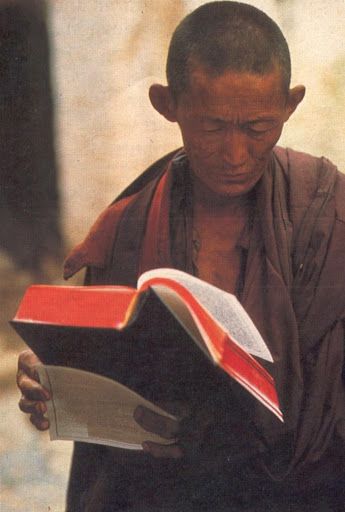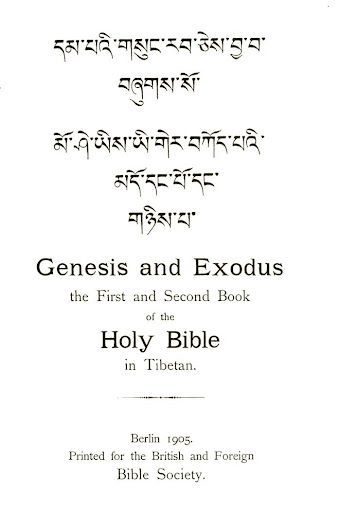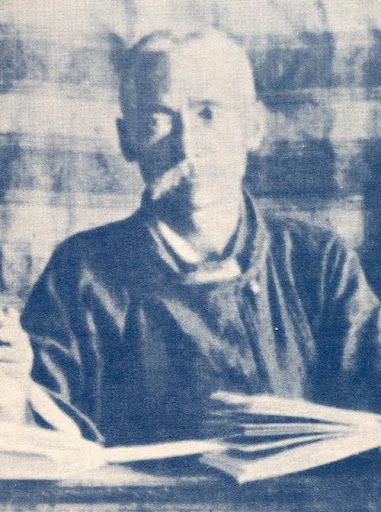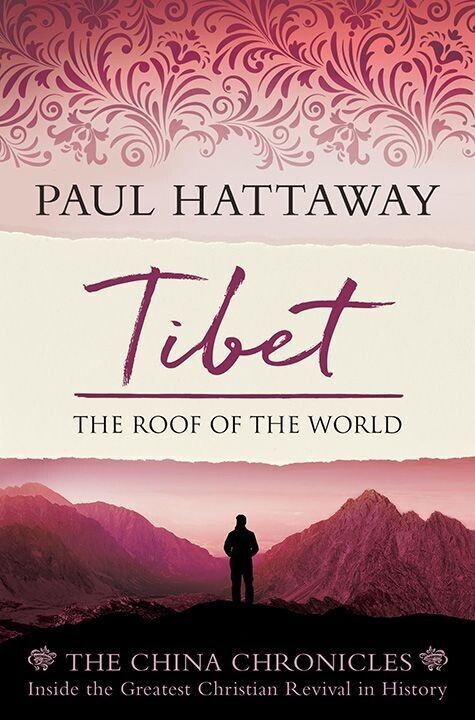The Story of the Tibetan Bible

How the Tibetan Bible came into existence is one of the most remarkable accounts of struggle and victory in the history of Christian missions. It is a story that deserves to be widely shared, and it highlights the level of spiritual opposition that Christian work in this dark part of the world attracts.
From the start, the Moravian missionaries in north India knew that the translation of the Scriptures into Tibetan would be one of their major projects, and they gave themselves fully to the task in 1856. Incredibly, it was to take nearly a century to complete, with the first full Tibetan Bible finally being published in 1948.
The Gergans — a Family of Peace
After the pioneer Moravian missionaries Heyde and Pagel found their way to Tibet blocked, they searched for a suitable location from which to base their work. After traveling for a week they entered the sparsely-populated Luba Valley, where God led them to a 'man of peace,' Tempu Gergan, who showed kind hospitality to the two wandering Germans. When the missionaries told their new friend of their desire to travel across the border into Tibet, Gergan was alarmed and warned them:
"I don't think you will ever get there. The government is determined to keep foreigners out. Even if you did get through yonder pass, it is many months of hard traveling to reach Lhasa. Long before you get there you will be seized and thrown back over the border. Why don't you stay here for a while? Many Tibetans now live in this valley."
Pagel asked Gergan, "Would you help us learn your language and help us write our Holy Book in the Tibetan script if we stay?" He replied, "Yes, I will be happy to do that," and so began a long and enduring relationship between Christians and the Gergan family; a bond that continues to the present day, and has seen hundreds of Tibetans come to a living faith in Jesus Christ.
Tempu Gergan died after falling ill in 1897. Although he himself had not openly professed faith in Christ, his 12-year-old son Sonam had listened attentively to all the discussions between his father and the missionaries, and he boldly decided to confess Jesus as Lord and Master. Sonam's decision angered the local lamas, and great pressure was applied in a bid to make him abandon his new faith and return to the Buddhist fold. He rebuffed their threats, and later that year he was publicly baptized and adopted the new name of Yoseb (Joseph).
Yoseb had inherited his father's wealth and land, and after obtaining a good education, the young man faced a difficult decision. Part of him wanted to be a merchant, and he knew he would enjoy great riches as his valley emerged as a key trading hub in the region. On the other hand, Yoseb desired to follow Jesus Christ no matter what, and to help provide the Word of God to his fellow Tibetans.
As he pondered what to do, Yoseb had a powerful dream in which he saw a caravan of mules stop outside his home. The merchants unloaded an array of expensive treasures: jade from China, wood carvings from Nepal, costly garments, and other exotic treasures. The leader of the caravan exclaimed: "These are your treasures, master, and more are yet to come."
Yoseb Gergan woke up in amazement. The experience had been so vivid that he was surprised to find it was only a dream. Tibetans believe that all dreams have a meaning, and as he contemplated the message, he dozed off and had a second dream. This time, "A few Tibetans sat in a humble church listening as the minister read from a great volume spread out on the desk. Leaning closer, Yoseb was amazed to see that it was a Tibetan Bible. The pages were written in letters of fire. The man preaching seemed shadowy and indistinct, but the voice was his own! Looking around, he saw the little group listening with close attention. Now the voice spoke again: 'Which way shall you choose, my friends? One way offers wealth and luxury, but no hope of eternal life. The other is hard, but leads at last to a golden city with joys forevermore.'
Yoseb awoke from his dream and pondered the message. God had spoken—of that he had no doubt. Slipping to his knees, he asked God to forgive him for his covetous spirit. Life in the valley would lead to great riches, but that was not the way God wanted him to go. As soon as possible he would leave all this behind and join the struggling work.
He divided the great estate among the servants who had cared for it through the years. When all was settled he rode out of the valley headed for Leh, leaving his old life forever."
Help from Above
The task of translating the Bible into Tibetan received a great boost when God sent a gifted linguist to the Moravian mission. When the 40-year-old Heinrich Jaeschke arrived on the Tibetan border in 1856, he could already speak several European languages fluently, including Greek. He also possessed a smattering of Arabic, Persian and Sanskrit. He immediately immersed himself in the local community, and was soon able to converse in Hindi and Urdu.
To achieve his goals, Jaeschke enlisted the help of two former Buddhist lamas. Finally, after a painstaking struggle, the Gospel of John in Tibetan was published in 1862.
Although a portion of the Bible was now available, it was not well accepted by Tibetans, who struggled to understand the words and concepts it contained, causing many readers to give up in frustration. Years of discouragement ensued as the Tibetan Christians and missionaries tried to share God's Word with local Buddhists, only to encounter uniform apathy and disinterest.
From the start, the translators had struggled with what terms they should use to portray Christian concepts and names to a completely non-Christian culture. Long discussions and prayer meetings were held over what Tibetan words to use for God, Savior, and sin, among many others. Each word that was tried had Buddhist connotations, and it seemed impossible to find terms that were unique, yet communicated the beauty of God's Word to a people steeped in superstition and a completely different worldview.
Another major hurdle to overcome was the choice of which Tibetan script to use. Should they translate the Bible into classical Tibetan, as used by the lamas, or into the language of the common people? The problem was a double-edged sword. If they chose the common script, the Bible risked being disrespected by the Buddhist hierarchy and viewed as an unholy book. On the other hand, if they chose the classical script, only those men and women who had been taught to read in Buddhist monasteries and convents would be able to understand it.
One morning, feeling frustrated and defeated, Yoseb Gergan set out on a long walk to a Tibetan village north of Leh. By lunchtime the intense heat caused him to rest in the shade with his back against the wall of a small Tibetan temple. As he rested, he idly listened to the resident lama chant and beat his prayer drum. Suddenly, as if jolted to life, the lama's words registered in Yoseb's mind:
"Could it be true? The lama was reciting from some ancient book that seemed to contain the very phrases the translators had searched for. Rushing into the temple, Yoseb begged to see this strange book....
Reverently the old lama lifted the faded pages for Yoseb to see. 'You ask where this book came from? Only the gods know. My father read from this book, and his father before him. It was written by the gods themselves'...
The language, written in an almost forgotten dialect, amazed Yoseb. He saw at once that this language was the key for which they had searched. Here was the word for 'God' which they had so diligently sought, a good word for 'prayer,' and other difficult phrases. The language, much simpler than classical Tibetan, could be adapted so that the modern Tibetan would understand it clearly—even the simple people of the hills."
Yoseb eagerly begged the elderly lama to let him to borrow the book, and the old man replied:
"Never have I allowed another to touch that book. It has been a treasure carefully guarded. No stranger could ever take my book—and yet, somehow I feel you ought to have it. I do not know why I do this, but I want you to take the book and share it with others. Soon my spirit will escape from this shell, and there is no one to take these books from me. Take it, my son, and may the gods be with you."
Finally, in the most unexpected way, the translators had been given the key to unlock an effective Tibetan Bible translation. The work continued at a new pace, with the books of Hebrews and Revelation next to be completed.
When the entire New Testament was ready for publication, the final proofs were sent to Jaeshke in Germany, where he made some corrections before it went to press. Unfortunately, the health of the linguistic genius had broken down, and he went to be with Jesus Christ in September 1883, aged 66.
More years elapsed as the entire translation underwent a revision. The New Testament was finally completed in 1903, and Yoseb Gergan immediately commenced work on translating the Old Testament.
Although the publishing of the Tibetan New Testament did not cause an outbreak of revival, it greatly strengthened the small remnant of Tibetan believers, and the profile of Christianity was greatly enhanced among the Buddhist hierarchy now that God's Word was available for them to read. In 1926 the abbot of one monastery told the missionaries:
"I have read all the New Testament. Is it true that there is an Old Testament? If so, will you kindly send me all the books? I am much interested in Christianity."

Wrestling with the Devil
Many more years went past until finally, in 1935, Yoseb Gergan laid down his pen. He had on his desk the first draft of the complete Tibetan Bible! He let out a deep sigh. Now, the Holy Bible would be available to reach the millions of Tibetans living on the vast plateau beyond the passes.
Incredibly, another 13 years of intense struggle elapsed before the full Tibetan Bible finally saw the light of day, as a succession of extraordinary events threatened to totally destroy the decades of work. It seemed as if every demon in hell had gathered to prevent the Word of God being available in Tibetan.
First, the workers at the Bible Society in India were unable to print the manuscript because they didn't possess the technology to do so. At a time long before computers or photocopy machines, the precious manuscript was carefully placed inside a crate and sent to the headquarters of the Bible Society in Britain.
The Tibetan Bible arrived in London, but as Hitler's forces swept across Europe, the Bible Society was concerned that the valuable manuscripts in their vaults might be destroyed by a Nazi bomb, so they arranged to transport the documents to safer rural locations. The Tibetan manuscript was placed in an underground vault inside the ancient cathedral at Ripon, 200 miles (324 km) north of London. As the Battle of Britain raged, "One 2,000 pound [907 kg] missile from the skies landed on a roadway beside Ripon Cathedral and came to rest against the wall of the church without exploding. Four feet away, inside the church's wall, lay the Tibetan manuscript. Gingerly, a bomb demolition crew defused the bomb. The firing device seemed faultless, and they could not understand why it had failed to explode."

By the time the Second World War ended, Yoseb Gergan was 60-years-old. For a decade he had waited patiently for news about when his Tibetan Bible would be printed. With Europe in disarray and no sign of progress, he asked that the manuscript be returned to India, hoping that new technology there would allow it to be printed closer to home.
Alas, the printers in India shook their heads, saying the manuscript had been written on cheap Tibetan paper and the type could not be reproduced. The entire manuscript would need to be rewritten on special white paper. Years after sending them off, Gergan received his precious manuscripts back, and he asked God to give him the strength to complete the massive undertaking.
Two more years passed, and Yoseb felt his strength was beginning to ebb as he continued working on his life's task. Then disaster struck. After days of feeling dizzy as he worked from sunrise to late at night, he fell to the ground, gasping for breath. Yoseb Gergan had suffered a heart attack.
The members of the small Tibetan church in Ladakh cried out to the Living God, asking Him to have mercy. They had never imagined that their beloved pastor would die before the Bible was in circulation. God heard their prayers, and Yoseb experienced a surge of strength. A special table was constructed so he could continue the work from bed, and two Tibetan scribes were employed to do most of the writing, with Yoseb overseeing their work and making corrections.
Finally, on August 11, 1946, Yoseb Gergan wrote down the Tibetan words for the final verses in the Bible: "Surely I come quickly. Amen. Even so, come, Lord Jesus. The grace of our Lord Jesus Christ be with you all. Amen" (Revelation 22:20-21).
Five days later, Yoseb Gergan closed his eyes one last time, and went to his eternal reward.
Ninety years had passed since the Moravian missionaries first took up the task of producing the Bible in Tibetan—and 84 years had elapsed since the Gospel of John was published—but now the translation of the entire Tibetan Bible was complete!
A Soggy Pulp
Unsurprisingly, more demonic opposition and roadblocks had to be overcome before the Tibetan Bible was finally printed. The rewritten manuscript had to be taken on the back of a mule across the steep mountain passes to Leh, the capital of Ladakh, and a young Tibetan named Sandrup was employed to deliver the manuscript. The journey to Leh was expected to take 50 days, and from where the manuscript would be sent on to the city of Lahore, where the Indian Bible Society was headquartered.
Months went by without any word from Sandrup. He, and his precious cargo, had simply vanished in the remote wilderness. The believers worried that he had been murdered by bandits or had encountered some other disaster.
Thankfully, another set of proofs had been made by Yoseb Gergan. They were given to a Christian named Bahadur, who retraced the steps of the missing Sandrup. As Bahadur crossed a mountain pass, a massive electrical storm came rolling up from the valley below. He pulled his horse behind a large boulder and squatted close to the ground, waiting for the storm to pass as hailstones the size of eggs smashed into his back and neck. Suddenly, "There was a searing flash of light followed by the crash of thunder. The horse tried to bolt into the darkness, but Bahadur restrained it with tremendous effort. Flash after flash of lightning glanced off the rocks around them, filling the air with the heavy smell of scorched earth. The thunder roared as though the demons of hell had gathered to defy the terrified traveler. Torrential rain followed the hail, pouring from the heavens like a waterfall....
'Oh God,' he cried, 'help me now. Deliver me from Satan and his evil host. Protect your Book!' His shouted prayer was answered by another flash of lightning, which laid him out insensible on the ground.
When consciousness struggled back, the storm had passed. He noticed that all was quiet, and he suddenly realized he was stone deaf.... It would be weeks before he would hear a sound, and then only faintly, as the storm had split his eardrums."
Bahadur bravely soldiered on, and finally reached the Christian chapel in Leh. The scribes came running out to welcome him, but when the saddle bags were opened, a soggy mass of paper fell to the ground. The storm had succeeded in filling the bags with water. Bahadur "tried to pick up the sticky mess, but it was no use. His journey had accomplished nothing. He called God to witness what the devil had done to the precious papers."
One Final Effort
The staff members at the Bible Society realized they were in an intense spiritual battle that required a far greater power than mere human effort to overcome, and they petitioned Christians in many nations to intercede for the success of the Tibetan Bible project.
After another delay, a third set of proofs was successfully sent to Leh, and the final draft was sent for printing. Meanwhile, the body of Sandrup, the first courier, had been found at the bottom of a steep cliff. He had perished in an avalanche.
Due to the outbreak of war which would lead to the formation of Pakistan as a separate country in 1947, it wasn't safe to send the manuscript to Lahore. It would have to be personally carried across the dangerous mountains, and one of the Tibetan scribes, Gappel, volunteered to undertake the months-long journey. He entered the war zone, and for months not a word was heard from him.
Four months later, as the Bible Society workers were giving up hope of ever seeing Gappel or the manuscript again, news emerged that he was holed up in a little hut in Kashmir. His way to Lahore was blocked by soldiers, and he could not return to India because of the advancing Indian army.
However, after another series of divine interventions, the manuscript finally arrived in Lahore, where Gappel began to put the finishing touches to the work.
The searing heat and humidity of Lahore soon made Gappel fall ill, as he had spent his whole life in the crisp air of the Himalayas. Two large fans were installed in his room, and 50 large blocks of ice were placed in front of the struggling Tibetan. His spirit was immediately revived by the cool environment.
With Gappel working up to 20 hours a day to finish the task so he could return home progress was swift, and the wonderful day finally arrived in August 1948, when the first ever copy of the full Tibetan Bible rolled off the press!
God's Word Goes Forth
As soon as his job was done, Gappel hastily headed back to his home in the mountains, as an initial print-run of 5,000 Tibetan Bibles was dispatched to expectant missionaries and Tibetan Christians on both sides of the Himalayas.
One recipient of a new Tibetan Bible was Tenzin Gyatso, the Fourteenth and current Dalai Lama, who had fled from Tibet into north India. When a missionary presented him with a brand new copy of the Holy Bible, the Dalai Lama exclaimed, "Thank you! I have heard about this Book, and have seen it only once before.... I am told it speaks of the great God who became a man and lived on earth."
After the Communists took control of Tibet, hundreds of thousands of Buddhist monks were arrested and sent to prison labor camps, where many died after facing horrific cruelties. A Bible reached one imprisoned lama, who after being deeply touched by the words he read, penned a letter in beautiful flowing Tibetan:
"Dear unknown friends. The book you have sent over the mountains has come to my lonely cell. My soul is strangely stirred as I read these words. Light has come to my poor darkened soul. Please send me more light."
© This article is an extract from Paul Hattaway's book ‘Tibet: The Roof of the World’. You can order this or any of The China Chronicles books and e-books from our online bookstore.
1. Maberly, God Spoke Tibetan, p. 69.
2. Maberly, God Spoke Tibetan, pp. 84-85.
3. Maberly, God Spoke Tibetan, pp. 88-89.
4. Maberly, God Spoke Tibetan, p. 90.
5. Marshall Broomhall, The Bible in China (London: China Inland Mission, 1934), p. 121.
6. Maberly, God Spoke Tibetan, pp. 95-96.
7. Maberly, God Spoke Tibetan, pp. 103-104.
8. Maberly, God Spoke Tibetan, p. 104.
9. Maberly, God Spoke Tibetan, p. 140.
10. Maberly, God Spoke Tibetan, p. 143.





